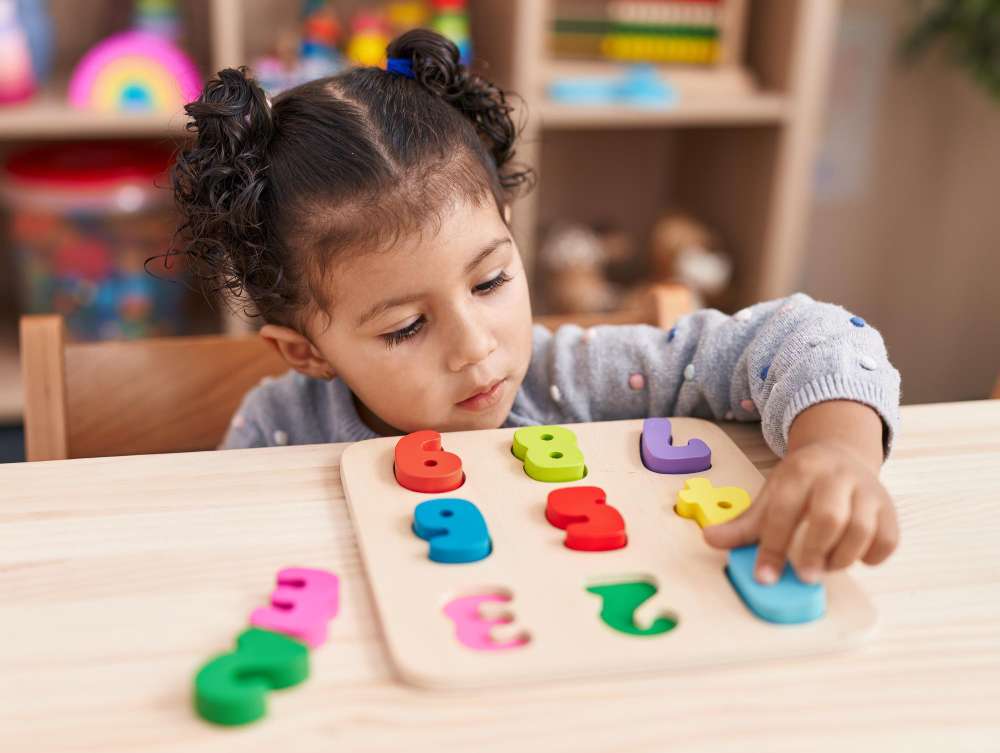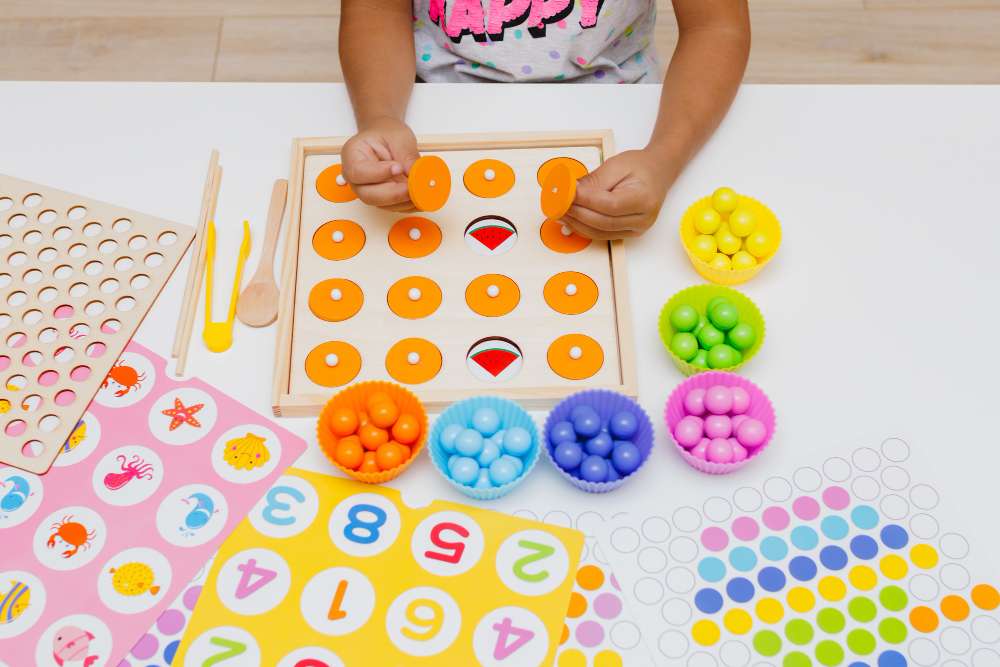Math in the early years is all about discovery and fun. Basic numeracy problem-solving sets the stage for deeper understanding. It’s the first step. But remember, it’s not just about knowing that two plus two equals four. Instead, it’s about seeing how numbers play a role in daily life.
For instance, when your child sees three apples and takes one away, they are left with two. Simple, right? That’s basic numeracy problem-solving in action. It’s these little experiences that shape their understanding. Gradually, they’ll start recognizing patterns. Maybe they’ll notice that every time they take away one toy from their collection of four, they’re always left with three.
So, why is this important? Well, it goes beyond just math. It’s about helping your child navigate the world around them. From dividing candies with friends to saving up their allowances, numbers are everywhere. And as they grow, these foundational skills will come in handy. So, let’s make it fun for them! Together, we can turn everyday moments into learning opportunities.
Understanding Preschoolers’ Cognitive Development in basic-numeracy-problem-solving

First off, kids aren’t just mini-adults. They’re unique, with minds buzzing with curiosity. Their brains are like sponges, eagerly soaking up information from the world around them. You might have noticed how they get fascinated by simple things, like the sound of a bell or the colors of a rainbow. That’s their natural curiosity at play.
Basic numeracy problem-solving is about making sense of their surroundings. As adults, we often take shortcuts in our thinking. We instantly see four apples as a group. But for a preschooler? They see an apple, then another, then another, and then one more. They’re taking it step by step.
This is where the magic of math games and activities shines. These aren’t just games. They’re tools. Think of them as bridges, linking their natural way of seeing things to the structured world of numbers. So, when you’re introducing them to math, it’s essential to remember this difference. By tapping into their unique way of understanding, you can make their math journey not just educational, but truly magical.
Setting the Stage for Numeracy:

You know, setting up the right environment for your little one is like prepping the soil before planting seeds. It’s all about the groundwork. It’s not just about toys or books. It’s about the vibes, the energy, and the opportunities you create. An atmosphere where curiosity isn’t just allowed but celebrated. A safe haven where making mistakes isn’t frowned upon but seen as a part of learning.
Let’s talk examples. Say you’re playing with toy cars. You’ve got five shiny ones. Imagine taking away two and asking your child, “How many do we have left?” This isn’t just a random question. It’s basic numeracy problem-solving in action, and it’s framed in a way that relates directly to their play.
Ever thought about the power of stories? Simple tales can be math goldmines! Take the classic, “Once upon a time, there were three little pigs…” Here, numbers aren’t just numbers. They’re characters, parts of a story, making the whole learning experience enjoyable and memorable. Remember, it’s all about blending fun with learning. That’s the sweet spot.
Fun Numeracy Activities for Teaching basic-numeracy-problem-solving
Let us turn playtime into valuable learning moments. First, imagine “Number Jump.” Picture this: Numbers scattered on the floor, and every time you call one out, your child jumps to it. Not only is it energetic and fun, but it’s also sneaky learning in disguise. They’re having fun, and simultaneously, they’re sharpening their number recognition.
You might have blocks, beads, or even buttons at home. These aren’t just toys or household items. In the world of basic numeracy problem-solving, they’re treasures. Let’s say you give your child ten beads. Ask them to divide them into groups of two or five. What happens? They’re counting, dividing, and probably not even aware they’re doing math!
In essence, the goal is simple. We’re not trying to turn every moment into a strict classroom lesson. Instead, we’re blending learning with fun. By the end of the day, if your child sees math as play, you’ve hit the jackpot!

Incorporating Arts and Crafts:
Think about the last time you saw a child immersed in a world of colors, shapes, and textures. That’s the magic of arts and crafts. It’s not just about splashes of paint or stringing beads; it’s a journey of discovery and, believe it or not, math!
Consider the necklace-making scenario. Your child decides they want ten beads, but halfway through, they change their mind. Now they want twelve. Here, amid creativity, they’re practicing addition. And that’s basic numeracy problem-solving right there.
Now, picture them drawing. A lovely garden scene with birds, trees, and flowers. Later, they proudly show you their artwork and start pointing, “Look, three birds!” or “I drew five flowers here!” It’s an art piece, sure, but it’s also a counting exercise in disguise.
What makes arts and crafts so effective? It’s hands-on. They touch, they see, they feel, and through this, they understand. Numbers become more than just symbols on paper; they turn into real, tangible items they’ve created or used. And that, my friend, is how you make math lessons stick – by weaving them seamlessly into fun, creative adventures.
Outdoor Exploration:
Step outside, and what do you see? A world brimming with potential learning moments. Nature, with its vastness and variety, is like an open classroom.
Think about your local park. A seemingly ordinary setting, but oh, the math adventures it holds! The ducks splashing in the pond aren’t just cute birds to a child; they become a counting game. “Look, I see four ducks over there!”
Then there’s the ever-changing world of leaves. Some are big, some small, some round, and some long. Collecting them turns into a fun activity, but categorizing them? That’s where basic numeracy problem-solving comes into play. They might group leaves by size or even by the number of points they have.
The beauty of outdoor exploration is its spontaneity. You never know what nature will present next, but with every step, there’s a chance to connect math to the world. And in doing so, numbers become more than abstract concepts. They become real, touchable, and relatable.

Using Technology to Teach Basic-numeracy-problem-solving
We’re surrounded by screens nowadays. From phones to tablets, technology is everywhere. But guess what? This isn’t necessarily a bad thing for learning.
Let’s talk about those educational apps. Some of them are fantastic for introducing kids to numbers. Imagine an app where animated creatures teach counting or basic addition. Fun, right? These apps make learning interactive and engaging, turning math challenges into exciting games.
However, here comes the ‘but’. Basic numeracy problem-solving isn’t just about swiping on screens. Remember the ducks in the pond or the leaves we talked about earlier? Real-life experiences like those are irreplaceable. They provide a tangible connection to numbers, making math feel more real and less abstract.
So, the bottom line? Blend the old with the new. Let technology play its part, but always ensure that it’s complemented by hands-on, real-world math adventures. That way, you’re giving your child the best of both worlds.
Challenges and Overcoming Them:
Learning has its ups and downs. And when it comes to little ones, it’s no different.
You see, every child has their own pace. Some days, they’ll breeze through counting exercises. Other days? They might stumble on the simplest of math problems. That’s the roller coaster of basic numeracy problem-solving. And guess what? It’s completely normal.
Now, what’s vital here isn’t the number of times they stumble, but how they pick themselves up. Instead of focusing on the mistake, shine a light on the effort. A gentle nudge, a word of encouragement, or even a simple “Let’s try that again” can make all the difference.
For instance, if they’re struggling with subtracting, use tangible objects. Maybe count out toy cars or crayons. Sometimes, seeing and touching can help bridge the understanding gap.
But always, always remember this: The journey is more important than the destination. It’s not about being the quickest to get the right answer. It’s about fostering a resilient spirit, a curious mind, and an enduring love for learning.
Fostering a Positive Attitude Towards Math:

Let’s face it: Your energy is contagious. Children are like little mirrors, reflecting our attitudes and beliefs. So, when it comes to math, your perspective is powerful.
Imagine this: They come running to you, eyes sparkling, shouting, “I did it!” Maybe they’ve just counted to twenty for the first time or solved a small puzzle. It might seem trivial to us but to them? It’s a mountain climbed. So, cheer for them, clap, and even do a little victory dance. These celebrations instill confidence.
Now, every child has moments when math feels like a giant, scary monster. This is where you can get creative. Use toys, coins, or even fruits as tools for understanding. It’s much easier to grasp the concept of “three” when you’re holding three apples in your hand.
Lastly, always keep this in mind: It’s not about mastering equations or getting straight A’s. The real win? Cultivating a mindset that says, “I can try. And even if I don’t get it right, I’ll learn and grow.”
FAQ:
Q: How do I know if I’m overwhelming my child with too many concepts?
Recognizing your child’s comfort level is crucial. Children express their feelings in many ways, often non-verbally.
Emotional Responses: Sudden outbursts, tears, or even withdrawal can indicate they’re feeling pressured or overwhelmed.
Body Language: Is your child fidgeting more than usual? Are their shoulders hunched, or do they avoid eye contact? These could be signs of discomfort or confusion.
Verbal Cues: Listen to what they’re saying. Phrases like “I can’t do this,” “It’s too hard,” or repeated questions about the same concept can signal they’re struggling.
Lack of Engagement: If they’re usually enthusiastic learners but suddenly seem distant or uninterested, it might be an indicator you’ve introduced too much too soon.
Seek Feedback: Sometimes, it’s as simple as asking them. A straightforward question like, “How are you feeling about this?” can provide insights.
Remember, it’s all about pacing. Every child is unique, and their learning journey won’t always mirror that of their peers. If you sense they’re getting overwhelmed, it’s perfectly okay to slow down, revisit earlier concepts, or change the method of teaching.
Conclusion:
The world of numbers! might seem complex at first, but remember, it’s all about building blocks. Just as a mighty oak tree starts from a tiny acorn, your child’s math journey begins with basic numeracy problem-solving. The beauty lies in making it relatable, playful, and exciting.
Children have this innate curiosity, this sparkle in their eyes when they discover something new. Why not channel that towards math? With a blend of creativity, patience, and fun activities, you’ll see them light up as they grasp new concepts.
Your support, enthusiasm, and encouragement can turn math from a feared subject into a delightful adventure. So, as you both embark on this path, cherish the milestones, the stumbles, and the aha moments. Because in the grand scheme of things, it’s not just about numbers; it’s about instilling a lifelong love for learning.
Here’s to every equation solved, every puzzle pieced together, and every triumphant “I did it!”





